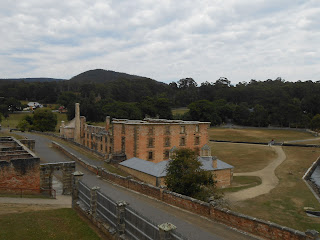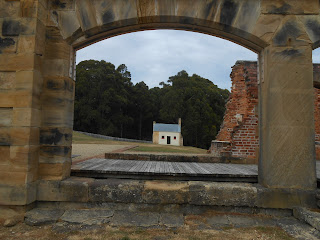After
rising early in the morning, we drove to Port Arthur - one of the infamous Australian penal
colony of the 1800s where many of the worst and repeat offenders were sent. En route we passed through many kilometres of charred forests, bush and fields (a
result of the recent horrific bush fires on the Tasman Penninsula). The amount
of property destruction was gut wrenching but it is
surprising how quickly infrastructure was starting to be rebuilt.
The penitentiary and its surrounding settlement, an Australian World Heritage Convict Site, was informative and fascinating. In its time it was considered to be both modern and cruel. Port Arthur is one of Australia's most significant heritage areas and forms part of the Australian Convict Sites originally built within the British Empire during the 18th and 19th centuries. It represents a sample of convict transportation and the colonial expansion of European powers through the presence and labour of convicts.
Rebellious personalities from other convict stations were also sent there, a quite undesirable punishment. Port Arthur had some of the strictest security measures in the British penal system. It was one example of the Separate Prison system that signalled a shift from physical punishment to psychological punishment. It was thought that the hard physical punishments, such as whippings, used in other penal stations only served to harden criminals, and did nothing to turn them from their immoral ways. For example, food was used to reward well-behaved prisoners and as punishment for troublemakers. As a reward, a prisoner could - maybe - receive larger amounts of food or even luxury items such as tea, sugar and tobacco. As punishment, the prisoners would receive the bare minimum of bread and water. Port Arthur had a "separate prison". Here prisoners were hooded and made to stay silent, this was supposed to allow time for the prisoner to reflect upon the actions which had brought him there. Many of the prisoners in the Separate Prison developed mental illness from the lack of contact and sound. This was an unintended outcome (although the insane asylum was built right next to the Separate Prison - coincidental?) In many ways Port Arthur was the model for penal reform, despite shipping, housing and slave-labour use of convicts being as harsh, or worse, than others stations around the nation. Some tales suggest that prisoners committed murder (an offence punishable by death) just to escape the desolation of life at the camp. The Island of the Dead was the destination for all who died inside the prison camps.
We spent the entire day clambering about the ruins, watching historical skits and taking a short harbour cruise to see the Isle of the Dead where both the convicts and the free settlers were buried.
The penitentiary and its surrounding settlement, an Australian World Heritage Convict Site, was informative and fascinating. In its time it was considered to be both modern and cruel. Port Arthur is one of Australia's most significant heritage areas and forms part of the Australian Convict Sites originally built within the British Empire during the 18th and 19th centuries. It represents a sample of convict transportation and the colonial expansion of European powers through the presence and labour of convicts.
Rebellious personalities from other convict stations were also sent there, a quite undesirable punishment. Port Arthur had some of the strictest security measures in the British penal system. It was one example of the Separate Prison system that signalled a shift from physical punishment to psychological punishment. It was thought that the hard physical punishments, such as whippings, used in other penal stations only served to harden criminals, and did nothing to turn them from their immoral ways. For example, food was used to reward well-behaved prisoners and as punishment for troublemakers. As a reward, a prisoner could - maybe - receive larger amounts of food or even luxury items such as tea, sugar and tobacco. As punishment, the prisoners would receive the bare minimum of bread and water. Port Arthur had a "separate prison". Here prisoners were hooded and made to stay silent, this was supposed to allow time for the prisoner to reflect upon the actions which had brought him there. Many of the prisoners in the Separate Prison developed mental illness from the lack of contact and sound. This was an unintended outcome (although the insane asylum was built right next to the Separate Prison - coincidental?) In many ways Port Arthur was the model for penal reform, despite shipping, housing and slave-labour use of convicts being as harsh, or worse, than others stations around the nation. Some tales suggest that prisoners committed murder (an offence punishable by death) just to escape the desolation of life at the camp. The Island of the Dead was the destination for all who died inside the prison camps.
We spent the entire day clambering about the ruins, watching historical skits and taking a short harbour cruise to see the Isle of the Dead where both the convicts and the free settlers were buried.
Alice the moose in prison
The lunatic asylum
Separate Prison
locked up 23 hours a day in solitary confinement, not allowed to talk or look at a face. Tthe guards even wore slippers so there was no sound.
locked up 23 hours a day in solitary confinement, not allowed to talk or look at a face. Tthe guards even wore slippers so there was no sound.
Solitary confinement;
Total darkness in this small cell 24 hours a day for up to a month a more
Chapel in the asylum where segregation was enforced too
Church
attended by convicts and the free settlers at the same time
We each got a card with a real convict's name.
Here we are finding out the story of our convicts.
Here we are finding out the story of our convicts.
After
dark, we participated in a ghost tour through Port Arthur and gained greater
insight into the misery and mystery woven through the prison lives of some of the
convicts.
















































No comments:
Post a Comment